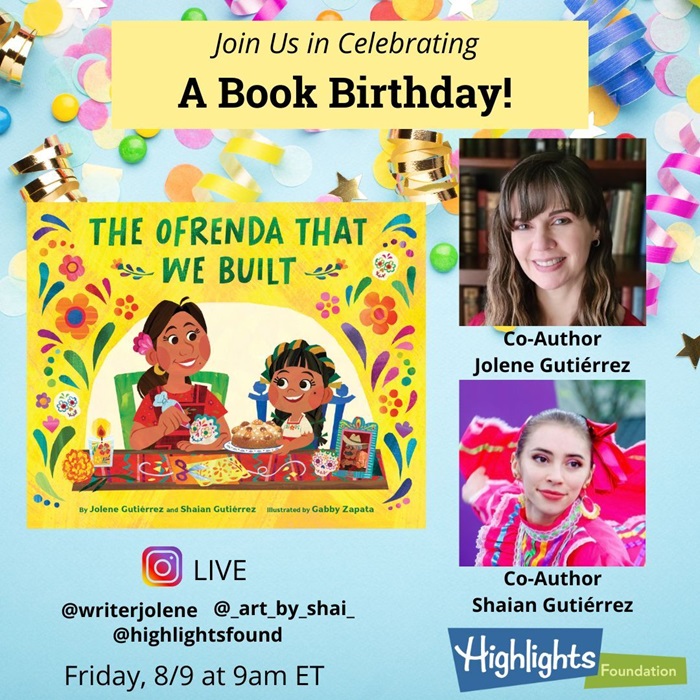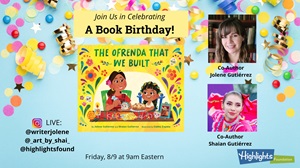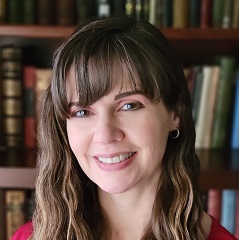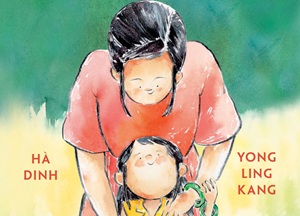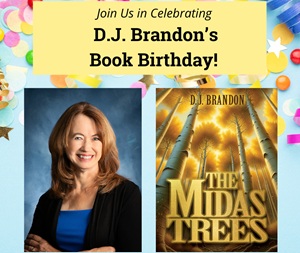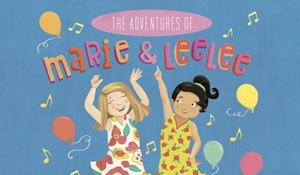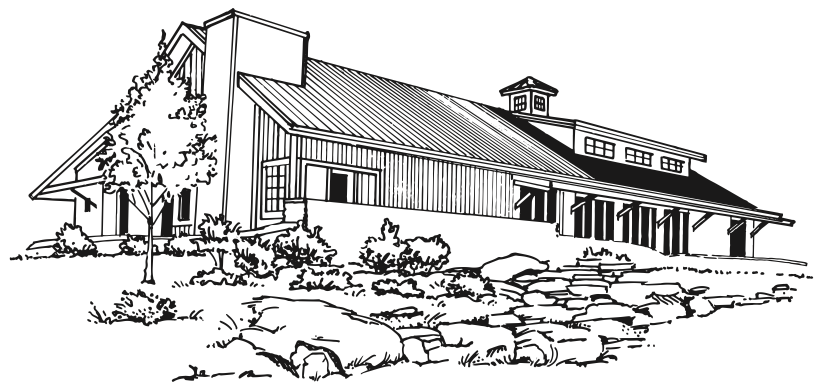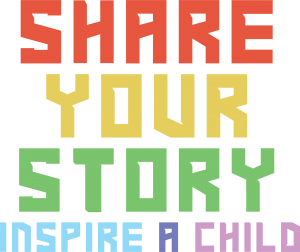Social Media Manager Cat Galeano joined Jolene and Shaian Gutiérrez on Instagram Live to celebrate the Book Birthday of The Ofrenda That We Built! It was a moving and emotional celebration of life, tradition and community.
Watch the conversation or read the full transcript below. (Please note: closed captions are being added to the video below. When they are finished, you can see them by hovering over the bottom of the video and choosing the “CC” icon.)
Full Transcript:
Cat:
A big hello to our Highlights Foundation family. We’re so happy to have you here with us. I know it’s early for some of you and later for some, some of you as well. So thank you so much for being here. For those that may not know me, I am Cat Galeano, my pronouns are she/her; I am the social media manager here at the Highlights Foundation, also known as the person who re-shares your posts and is responding to your blue and green heart. So, I’m the human behind all of that.
I’m joining you from Westchester, NY on the traditional lands of the Seewanoy people. And apart from all the fun things I get to do at the Highlights Foundation, one of my greatest joys is celebrating the book birthdays of our community members, faculty and friends. Because all of your wins, are our wins.
So today I have the honor of celebrating The Ofrenda That We Built, written by our friend and faculty Jolene Gutiérrez. And also here with us is her co-author, also daughter, so exciting, Shaian Gutiérrez, who is joining us from China. So thank you so much for being here. Both of us, we’re very excited to host you both with us today.
But before we dive in, I just want to remind our viewers that joining in on any Highlights Foundation sessions, to do so with no hate, no harm and no harassment of any kind.
So now let’s get started. So my first question, as I kind of teased already, is that you are a mother-daughter co-author team. How are you both feeling now that the book is out in the world?
Jolene:
Amazing. I mean this is; I have published a few other books but this is my first co-authorship project and to have it be with my daughter is just such a beautiful gift and I have the book with me because I wanted to show it off. It is, it’s just gorgeous. We’re so thankful for Gabby Zapata’s gorgeous illustrations and Chronicle Books’ support along this journey.
Shaian:
Yeah. No, I’m surprised as well. I actually have the book too. It’s just in my, it’s in my background over here somewhere. It, so it almost doesn’t feel real having just since I’m living here in China and not there yet to celebrate. But when I come back, I’m really excited to celebrate and…but it’s it’s crazy how this all started back. Just so a while ago, but when I was still in college, we were writing this and since then I’ve moved away. So it’s unfortunate I can’t be there to celebrate, but I’m really excited to celebrate with you here online.
Cat:
Yeah, that’s kind of like the beauty of this like post-pandemic world is like no matter where you are, you can still celebrate really big from like whatever corner of the world that you’re in. So thank you again for being with us today. Can you talk a little bit about how the overall idea of this book came to you and why you chose to co-write this?
Shaian:
Do you want me to go first?
Jolene:
Yeah, I’m trying to leave space for you to talk, too.
Shaian:
I’m Mexican American. My, my culture is very important to me. And my mom was always super supportive and–sorry–in in, in, supporting,supporting my, my identity and who I am and taking me to–sorry, I don’t know why this is being so emotional–taking me to museums and and…
Cat:
It’s an emotional topic.
Jolene:
Yeah.
Shaian:
And my, my culture is so important to me. I’ve always done, made art, Mexican art, like I love making bright patterns, things, painting that way. Uh, cutting marigolds for the…things like that. It’s always interested me just caring about my culture is important. Sorry.
Cat:
No, my God, you’re making me tear up. I’m like watching you hearing you. I’m like, I completely understand, like being seen, no matter by who and especially your parent. It’s, it’s just there’s nothing more powerful than that. So thank you for sharing because I’m over here wiping my tears too.
Jolene:
Me too, and Shaian knows I’m, I’m usually the one who who gets emotional and cries so, yeah, I was crying with you, baby. Yeah, from the time Shaian was born, I have looked for, you know, books to support her. Videos. Songs. I am not fluent in Spanish, but I’ve tried to read to her and sing to her and expose her to the language and she, as a college student, decided to double major in, in Spanish, is one of the things she majored in. So she is now fluent in in Spanish, and she spent time in Mexico. And I think part of this was like this reconnecting with roots and reclaiming traditions. And also for us, in 2018, my brother-in-law, Shaian’s uncle, passed away in 2019 on November 1st. Which is the start of the Dia de Muertos. My father passed away and so all of those things kind of culminated in making our ofrenda a really important way to kind of heal and connect and remember. And that led to us writing this beautiful story. And Shaian is also extremely musical. She was first chair Viola in high school and her ability…Sorry, I have to brag about you, sweetie.
Cat:
I’m ready, I’m ready.
Jolene:
Uh, her musical ability was so helpful because writing and rhyme is really hard for me. It is a challenge and there were times I would kind of go “rhyme and rhythm deaf” when we were working and she always had it. Like she would be like: “No. No, mom, it’s this.” It’s, you know, like, so that gift being able to, you know, show off each other’s strengths. Her ability to choose beautiful words and just really celebrate this holiday was such an awesome thing.
Cat:
Well, that kind of jumps into my next question is like I adored the rhyming in it because usually they always tell you like oh, “rhyming is so hard. Like, don’t do it. Stay away from it.” But I think the, the fact that this was a rhyming story, I think really brought to light the ofrenda–that like, all the elements of what makes an ofrenda. And plus the illustrations. We can’t speak enough about Gabby Zapata’s illustrations that were just like, just jumped off of the page right at you, they were so beautiful. And why did you decide to do this sort of repetitiveness, rhyming style, because–A, I commend you as a writer myself–But two, as a reader, I was like, Oh my God. How fun. It’s just like the lyricalism of, like, reading it; I read it. Thankfully, I had the honor of reading it multiple times before we got to chat today. So I just wanted to say hey, thank you. It was such a clever way to tell this story. But two, why did you decide to do it this way? And, and essentially like every repetitive verse kind of added to the layer of the visual so…basically, talk to us about why you went this route and you know: all the things.
Shaian:
Um, the rhyming scheme that we were following is actually based on The House That Jack Built. We were talking about, like, building a ofrenda is a process that kind of builds upon itself. Every element had; there’s multiple pieces and there’s multiple meanings that you have to understand. There’s, there’s also just the fact that it’s a, it’s a celebration. It happens every year–it, in itself, in its nature is repetitive and…By by the end, on top of that, more educational, educational. I think it’s very helpful and in helping students or children who are reading the book to, to really memorize the elements. Memorize the meanings, understand more about this opportunity, more about De de Muertos
Jolene:
Yeah, I agree. I honestly can’t add much more. It just like as at some point as we were working on our ofrendas and just kind of talking about the elements, it was like, wow, this is kind of, it’s, it reminds me of This is the House That Jack Built. Here are these different, you know, like we’re adding this, we’re adding this, we’re adding this. Which isn’t really fully how the House That Jack Built goes. But the layers, like Shaian mentioned, of the ofrenda and just that building piece and the community piece and Shaian, that’s such a good point about the rhythm of, you know, just the way the quality falls too. And how kids…I think it’s so beautiful. I’ve shared this book only a little bit so far. But already some people are like, Oh yes, I’m, I’m familiar with ofrendas and I know you know, like so it’s, it’s affirming because they get to hear about some of these pieces that they may also include on their ofrendas. Which that’s a beautiful thing that I love about Dia de Muertos. This is just kind of the way that you can take what works for you. It’s, you know, like it’s you don’t have to use all of these elements. But some some kids are already like, yes, I know that,I know this. But for other people, it’s a, it’s a total education. And that’s really beautiful too, that they’re learning these new pieces and the,the way that you can honor and remember people and celebrate.
Cat:
That’s kind of what I want to jump into is like: I’m Latina, but like my family’s from Paraguay. So, like, we don’t necessarily celebrate the Dia de los Muertos to this extent and like even I find myself who has been, of course grew up with understanding with the, with the notion of it was and what an ofrenda is and like friends and family that do, do that. But again, like the repetitiveness truly brought it home for me. Because I was like ohh wow. Like even me at like my big age was like, Oh my God. I’m learning something new so I’m just like ohh this. It was just so clever and like I can’t thank you enough for like, the way you just like built it, it was just so informative and fun and just like an all-around joy to read to myself and aloud. So I’m like, I can’t wait for like all the schools to be reading this come like late October, early November, I think this is going to be a staple in schools and homes. I’m just, I just love it. Like, thank you. Like, it was just the biggest joy to read. And just to learn as well. So I’m imagine.
Jolene:
Thank you.
Cat:
Yeah, I’m just like, I’m also so emotional with both of you. Because there’s something to be said about seeing something that’s so important to you and seeing it on pages so that others can learn. And like I mentioned, I’m Latina, which that doesn’t really do the whole ofrenda thing, but I’ve always found it to be so gorgeous and beautiful. And something I wish I could do myself. And I’m like, maybe this year I will because I’m inspired, yes. I guess that’s just like a tangent question is: when were you were conceptualizing this book and and sort of gathering your thoughts about it, did it come from a place of like, experience, like self experience of having you know this be a staple of your family life? Or was there a research component as well, or was it kind of both? So just curious about like how that, cause it like it feels very, like the elements that you list like on the pieces of your ofrenda that just feel like it was so researched but also felt so personal. So I just kind of want to touch a little bit on how that process was.
Jolene:
Yeah, it was, it’s both because we and, and as I mentioned with, you know, more recent deaths of, of people in our family, the ofrenda became more important and more, you know, just a huge piece of our lives. But then as we started writing, there were certain things like copal, the incense, that we didn’t have and hadn’t included, but it’s such, such a beautiful piece and, and speaks back to, you know, the indigenous roots of this holiday, that’s kind of my feeling. Shaian, please chime in! So there are certain things that we hadn’t included and personally, I don’t think I was aware of that before researching. But then we’re like, oh, no, we need to also include this and honor, you know, this piece of the tradition as well.
Shaian:
Yeah, I think, I think I, I agree, a mix of both and it was also just super interesting to look into that, to look into all the other comments that we didn’t include in our ofrenda and the ways that they build their own. They could, they could really take it, jus,t just however it fits them, however it fits their family or themselves. It’s just an individual it, it’s just a personal thing to you. This is a very personal holiday, it’s, ofrendas are very personal offense is a very personal and elements over whoever you’re honoring, how you see them. Or what you think would be important to them.
Cat:
I loved it. It was just, I found it so incredibly powerful, that like the extra stuff that you added that you,you learned in your research. So thank you once again. Thank you. So we’re kind of heading to the end of our conversation, although we’re not quite there yet, but I did want to talk a little bit about Highlights. Of course, that’s why we’re, we’re gathering today on the Highlights Foundation page. So I’d like to talk a little bit about what your journey and how, well, your journey in general as a writer and–both of you as weriters–but also how the Highlights Foundation has played a role in it.
Jolene:
Uh, so Highlights for me. I mean, I grew up reading Highlights magazine. It’s kind of Highlights has always been a part of my life. But I, at a local SCBWI conference, I don’t know, before 2016, I had a friend, Kelly Crocker, who said, have you ever been to the one of the Highlights classes? One of the retreats, and I was like, no, I didn’t know. They did that and that was the first time I had heard about the Highlights Foundation and the writing classes and all of the support. And then soon after that I, I won a teaching award that included a financial piece for professional development and I was able to use that to go to the 2016 Summer Camp and met some lifelong friends. I, I saw one of them, Liz Rice, on here. So there may be others. I apologize if I didn’t see your names because I get distracted but, yeah. So people that I’m still in touch with and I learned so much and then in 2018 I returned to do the Nuts and Bolts of Science Writing there on campus and again, made lifelong friends and connections and learned so much and–time for tears again–I, in 2019 I had learned about a verse novel workshop that was going to be happening the summer of 2020, and started making payments toward that because I knew I wanted to go. And when my dad passed in November of 2019, my mom told me he had set aside some money for me to attend.
And I didn’t get to attend that session. And I, I intend to return at some point, hopefully soon. I would like to do this upcoming summer. But during, uring the pandemic, well, Highlights did for all of us to just kind of offer different programming and yoga and ways to connect and community gathers and things like that. Shaian was able to kind of be a part of that and see me thriving because of that and Shai, you might want to speak more to that. But that kind of, you know, w we were writing during that time we were creating during that time and Highlights was there for us even though we couldn’t physically go to that space.
Cat:
I’m just like: 9:00 AM sessions are not recommended because clearly they’re just tear fests! Because I’m over here, like, oh, my goodness. Same, same, same! I, I was working for Highlights during that time and I completely can relate because it was such a chaotic time and all our lives and everybody was just not understanding what was going on. So the fact that there was a safe place to meet online and learn different things. And at that time, we had a lot of free programming. Which I’m grateful for you because that allowed a lot more people to to find us. And, and yeah, spend time with us. And and again it kind of goes back to this theme of being seen. And like your dad left yousomething because he saw you as the author that you are and it’s just kind of incredible that this is sort of our theme of this book is being seen and and Oh my God, I’m going to start crying some more.
Jolene:
I know. Being seen, being celebrated? And supported.
Cat:
Yes, celebrated, and supported and seen. I couldn’t have said that better myself. So we’re going to jump into our last question. So then we can secretly cry ourselves after we finsh. What do you hope kids will take from this? We’ve spoken a little bit about you, Shaian, me; I think adults, but like what do you think, what do you your kids will take from this?
Jolene:
Well for me, there, there was a session I was doing with a different book of mine, Mac and Cheese and the Personal Space Invader, that has Spanish sprinkled throughout. And as I was reading it, a little boy said “that’s my language! That’s, isn’t that beautiful?” And I, it’s like: yes, isn’t it beautiful? And that is what I hope, I hope that anyone who celebrates or, you know, has even heard of Dia de Muertos and identifies in some way, will,will have that feeling, like: that’s me. That’s my heritage. That’s my holiday. And I hope that anybody who hasn’t, who maybe even hasn’t heard of this celebration or doesn’t know what an ofrenda is or can’t pronounce the word, will still see the beauty and understand and, and take that. I mean that is also the beauty of this tradition in so many places. I’ve heard people say: you do not have to be of Hispanic heritage or Latina to celebrate this, like you can take this and make it your own. You can take what works for you, and I love that generosity of, you know, like not like, this is our holiday, but this is for anyone who connects. If it is helpful, take that. So that’s that’s my hope.
Shaian:
Yeah, I couldn’t agree more. I’m on the same exact page, especially I guess, my mom connects me to that so in the same way and now we’re helping hopefully have kids connect to our book in the same way and I think, um, just I, I think it’s important that they can see how bright and beautiful Mexican culture can be as well. And I think Gabby Zapata did such a good job with that. The illustrations could not, they’re just so beautiful. And so I they hope learn about it too. I want like, I want Mexican kids to read it and learn something new themselves to be like: I didn’t know about that element, for example. And to take that further, to understand, to pass on the tradition and, and I think it’s it’s just so important to educate everyone about about this holiday, about the significance behind everything. And even I, I just kind of I feel like I get a little too into like: oh it’s about tradition. I want to say like a traditional ofrenda can, it can include other elements. For example, my uncle’s ofrenda, here’s a little like Broncos helmet–he loved the Broncos. It doesn’t have to be traditional in that way. It has to, it has to be personal. Again, like I said before, so I think it’s important to me that kids read this and they understand the holiday and then they can ask themselves how are they gonna celebrate Dia de Muertos? How are they gonna make their own ofrendaand and what, what they get out of it?
Cat:
And it’s also like, at the end of the day, we all love. So like we all love and we all grieve for somebody that we, we loved and they always say, like grieving is just like the personificaiton of love that can’t go somewhere. So it’s like if you can pour into something like, something like an ofrenda, that’s like the biggest thing you can do. Like you said, your uncle’s little Broncos hat is like he loved that so much. Therefore, you honor him with having that on your ofrenda, that and I think that’s so beautiful the way you can, of course, have the traditional elements, but also incorporate the loved one that has has moved on. Yeah. And isn’t it a big and beautiful thing to love someone so much that you want to honor them every year like that?
Congratulations to you both. This book baby is is a book baby. Really, really came out bright and beautiful into the world. And for those, of course, that may want to order this book– which please, do yourself a favor: Go and order it. You can purchase the books at our Virtual Bookshop powered by bookshop.org. Jolian, I think there was another bookstore that you mentioned to me that you were working with? I don’t remember.
Jolene:
Locally. There’s Second Star to the Right Bookstore here in Denver, so. Because Shaian’s in China, she won’t be able to sign any books here in the States for a while. But I can sign and personalize if anybody wants a signed book, just reach out to me or Google Second Star to the Right in Denver and they have books in stock. Thank you, Cat.
Cat:
Thank you. We’ll also drop that information in the blog post that we’ll make of our conversation today. So that way, if anyone wants a direct signed copy at Jolene’s local. And of course, Shaian will eventually sign. So yeah, if you’re, if you’re patient, don’t be patient. Just buy 2 copies.
And also Jolene will be co-teaching with us this fall for the class Research Techniques: A Two-Night Mini on October 22nd and 24th. Which is like crazily creeping up on us. So like, please take a look at our website highlightsfoundation.org so that way you can take a look and register.
And yeah, thank you so much, Jolene. Thank you so much, Shaian. Thank you for joining me on super-early time, super-late time. And I can’t. I have been so moved by this conversation and I can’t thank you enough for your candor, for your vulnerability, for this beautiful project that you’ve brought into the world. So thank you. Thank you. Thank you. Thank you for everyone tuning in. I didn’t see any questions, just lots and lots of love.
Jolene:
Well, thank you.
Cat:
So that’s always good. A good way to, to go into the weekend. Yes.
Jolene:
Thank you so much, Cat. We appreciate this, this time to connect and talk.
Cat:
Of course, if there’s anything else you’d like to add, please go right ahead and if not, we will, we will say: until the next time.
Jolene:
I, I do wanna, can I piggyback a bit about the research class, because I did mean to mention that when we were talking about the Highlights connection and I spaced it of course, but. Yeah, this is Stephanie Gibeault, Anita Yasuda and I will be teaching and we have taught this in the past. Stephanie and Anita are amazing. I’m also a school librarian, so research is something that I love to do and love to share and teach how to do. So, if that’s something that’s of interest, I strongly feel like you need to research even fiction stories. You know I love research, so please join us if that resonates for you. Shai, do you have anything you want to add, baby?
Shaian:
No, just thank you so much. It was a good talk.
Cat:
Thank you both and piggybacking off Jolene’s piggyback, it is important to remember that we do have to research fiction so like even if you’re not a nonfiction person and not writing that style. You might need to research on something your fiction piece is about. So please, we encourage everyone to join. Oh, look, somebody’s already commenting that it was a great class. So you heard it here, folks. Totally. Sign up. Consider it. Thank you Shaian, for this beautiful, beautiful conversation. Thank you, Jolene, for this beautiful, beautiful book and conversation and both of you. Yeah, everyone, get on ordering that book–I know I am, even though I have a copy in ARC, I’m still gonna go get my own.
Jolene:
Thank you, Cat.
Cat:
Have a wonderful weekend.
Weekend. Thank you again, both of you, and we shall, we shall see each other again soon. I’m sure of it.
Jolene:
Yes, thank you. Shaian, I love you.
Shaian:
I love you too!
Cat:
Bye.
Jolene:
Bye.
